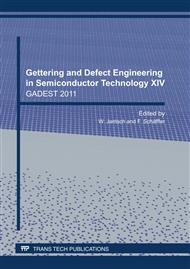[1]
T. Trupke, R.A. Bardos, M.C. Schubert, and W. Warta, Photoluminescence imaging of silicon wafers, Applied Physics Letters 89, 044107 (2006).
DOI: 10.1063/1.2234747
Google Scholar
[2]
N.A. Drozdov, A.A. Patrin, and V.D. Tkachev, Recombination radiation on dislocations in silicon, JETP Letters 23 (1976).
Google Scholar
[3]
M. Kittler, X. Yu, T. Mchedlidze, T. Arguirov, O.F. Vyvenko, W. Seifert, M. Reiche, T. Wilhelm, M. Seibt, O. Voß, A. Wolff, and W. Fritzsche, Regular Dislocation Networks in Silicon as a Tool for Nanostructure Devices used in Optics, Biology, and Electronics, Small 3, 964 (2007).
DOI: 10.1002/smll.200600539
Google Scholar
[4]
X. Yu, W. Seifert, O.F. Vyvenko, M. Kittler, T. Wilhelm, and M. Reiche, A pure 1.5 mu m electroluminescence from metal-oxide-silicon tunneling diode using dislocation network, Applied Physics Letters 93, 041108 (2008).
DOI: 10.1063/1.2965126
Google Scholar
[5]
R. Sauer, J. Weber, and J. Stolz, Dislocation-Related Photoluminescence in Silicon, Applied Physics A 36, 1 (1985).
Google Scholar
[6]
V. Higgs, M. Goulding, A. Brinklow, and P. Kightley, Characterization of epitaxial and oxidation-induced stacking faults in silicon: The influence of transition-metal contamination, Applied Physics Letters 60, 1369 (1992).
DOI: 10.1063/1.107293
Google Scholar
[7]
V. Higgs, E.C. Lightowlers, S. Tajbakhsh, and P.J. Wright, Cathodoluminescence imaging and spectroscopy of dislocations in Si and Si[sub 1 - x]Ge[sub x] alloys, Applied Physics Letters 61, 1087 (1992).
DOI: 10.1063/1.107676
Google Scholar
[8]
L.C. Kimerling, and J.R. Patel, Defect states associated with dislocations in silicon, Applied Physics Letters 34, 73 (1979).
DOI: 10.1063/1.90563
Google Scholar
[9]
P. Omling, E.R. Weber, L. Montelius, H. Alexander, and J. Michel, Electrical properties of dislocations and point defects in plastically deformed silicon, Phys. Rev. B 32, 6571 (1985).
DOI: 10.1103/physrevb.32.6571
Google Scholar
[10]
V. Kveder, T. Sekiguchi, and K. Sumino, Electronic states associated with dislocations in p-type silicon studied by means of electric-dipole spin resonance and deep-level transient spectroscopy, Phys. Rev. B 51, 16721 (1995).
DOI: 10.1103/physrevb.51.16721
Google Scholar
[11]
V. Kveder, M. Badylevich, W. Schröter, M. Seibt, E. Steinman, and A. Izotov, Silicon light-emitting diodes based on dislocation-related luminescence, Phys. Stat. Sol. (a) 202, 901 (2005).
DOI: 10.1002/pssa.200460512
Google Scholar
[12]
V.V. Kveder, E.A. Steinman, S.A. Shevchenko, and H.G. Grimmeiss, Dislocation-related electroluminescence at room temperature in plastically deformed silicon, Phys. Rev. B 51, 10520 (1995).
DOI: 10.1103/physrevb.51.10520
Google Scholar
[13]
V. Kveder, M. Badylevich, E. Steinman, A. Izotov, M. Seibt, and W. Schroter, Room-temperature silicon light-emitting diodes based on dislocation luminescence, Applied Physics Letters 84, 2106 (2004).
DOI: 10.1063/1.1689402
Google Scholar
[14]
Y.T. Rebane, and J.W. Steeds, Hole bound states in the deformation field of screw dislocations in cubic semiconductors, Phys. Rev. B 48, 14963 (1993).
DOI: 10.1103/physrevb.48.14963
Google Scholar
[15]
J.-L. Farvacque, and P. Franзois, Numerical Determination of Shallow Electronic States Bound by Dislocations in Semiconductors, Phys. Stat. Sol. (b) 223, 635 (2001).
DOI: 10.1002/1521-3951(200102)223:3<635::aid-pssb635>3.0.co;2-k
Google Scholar
[16]
A.J. Kenyon, E.A. Steinman, C.W. Pitt, D.E. Hole, and V.I. Vdovin, The origin of the 0.78 eV luminescence band in dislocated silicon, J. Phys.: Condens. Matter 15, S2843 (2003).
DOI: 10.1088/0953-8984/15/39/009
Google Scholar
[17]
E.A. Steinman, Influence of oxygen on the dislocation related luminescence centers in silicon, Phys. Stat. Sol. (c) 2, 1837 (2005).
DOI: 10.1002/pssc.200460513
Google Scholar
[18]
T. Sekiguchi, S. Ito, and A. Kanai, Cathodoluminescence study on the tilt and twist boundaries in bonded silicon wafers Materials Science and Engineering B 91-92, 244 (2002).
DOI: 10.1016/s0921-5107(01)01020-0
Google Scholar
[19]
T. Mchedlidze, O. Kononchuk, T. Arguirov, M. Trushin, M. Reiche, and M. Kittler, Determination of the Origin of Dislocation Related Luminescence from Silicon Using Regular Dislocation Networks, Solid State Phen. 156-158, 567 (2009).
DOI: 10.4028/www.scientific.net/ssp.156-158.567
Google Scholar
[20]
T. Mchedlidze, T. Arguirov, O. Kononchuk, M. Trushin, and M. Kittler, Structures responsible for radiative and non-radiative recombination activity of dislocations in silicon, Phys. Stat. Sol. (c) 8, 991 (2011).
DOI: 10.1002/pssc.201000367
Google Scholar
[21]
X. Yu, O. Vyvenko, M. Kittler, W. Seifert, T. Mtchedlidze, T. Arguirov, and M. Reiche, Combined CL/EBIC/DLTS investigation of a regular dislocation network formed by Si wafer direct bonding, Semiconductors 41, 458 (2007).
DOI: 10.1134/s1063782607040197
Google Scholar
[22]
A. Bondarenko, O. Vyvenko, N. Bazlov, and O. Kononchuk, Dislocation luminescence and electrical properties of dislocation network produced by silicon direct wafer bonding, Phys. B: Cond. Matter 404, 4608 (2009).
DOI: 10.1016/j.physb.2009.08.143
Google Scholar
[23]
A. Bondarenko, O. Vyvenko, I. Isakov, and O. Kononchuk, Correlation between cathodoluminescent and electrical properties of dislocation network in the space charge region of Schottky-diode, Phys. Stat. Sol. (c) 8, 1273 (2011).
DOI: 10.1002/pssc.201083995
Google Scholar
[24]
A.S. Bondarenko, O.F. Vyvenko, and I.A. Isakov, Identification of dislocation-related luminescence participating levels in silicon by DLTS and Pulsed-CL profiling, Journal of Physics: Conference Series 281, 012008 (2011).
DOI: 10.1088/1742-6596/281/1/012008
Google Scholar
[25]
I. Isakov, A. Bondarenko, O. Vyvenko, V. Vdovin, E. Ubyivovk, and O. Kononchuk, Electrical levels of dislocation networks in p- and n-type Si, Journal of Physics: Conference Series 281 (2011).
DOI: 10.1088/1742-6596/281/1/012010
Google Scholar
[26]
M. Trushin, O. Vyvenko, T. Mchedlidze, O. Kononchuk, and M. Kittler, Electronic States of Oxygen-Free Dislocation Networks Produced by Direct Bonding of Silicon Wafers, Solid State Phen. 156-158, 283 (2009).
DOI: 10.4028/www.scientific.net/ssp.156-158.283
Google Scholar
[27]
M. Trushin, O. Vyvenko, V. Vdovin, and M. Kittler, Giant Poole-Frenkel effect for the shallow dislocation-related hole traps in silicon, Journal of Physics: Conference Series 281 (2011).
DOI: 10.1088/1742-6596/281/1/012009
Google Scholar


